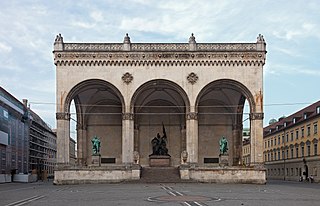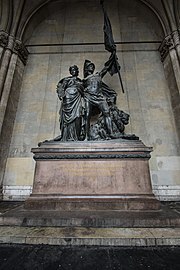Feldherrnhalle
The Feldherrnhalle (Field Marshals' Hall) is a large loggia in Munich, Germany. It was made similar to the Loggia dei Lanzi in Florence, Italy The building was commissioned in 1841 by King Ludwig I of Bavaria. He had it built to honour the tradition of the Bavarian Army.



In 1923, it was the site of the brief battle that ended Hitler's Beer Hall Putsch. During the Nazi era, it was a monument to members of the Nazi party who died there.
Structure
changeThe Feldherrnhalle was built between 1841 and 1844. It was built at the southern end of Munich's Ludwigstrasse. It is next to the Palais Preysing and east of the Hofgarten. Before it was built, the Gothic Schwabinger Tor (gate) was in that place. Friedrich von Gärtner built the Feldherrnhalle[1]> He was requested to do so by King Ludwig I of Bavaria.
The Feldherrnhalle was a symbol of the honours of the Bavarian Army. It included statues of two military leaders; Johann Tilly and Karl Philipp von Wrede. Tilly led Bavarians in the Thirty Years War. Philipp von Wrede led the fight against Napoleon.[2] The statues were created by Ludwig Schwanthaler.[3]
R A group by was added to the centre of the monument in 1892, after the Franco-Prussian War it represented the victory over France. The lions were created by Wilhelm von Rümann. They were added in 1906.
Site of the Beer Hall Putsch
changeThe Feldherrnhalle was the scene of a conflict on 9 November 1923. It was between the Bavarian State Police and the followers of Adolf Hitler. This was the end of the Nazis' failed attempt to take over the Bavarian State. That is commonly referred to as the Beer Hall Putsch. In the gun battle, four policemen and fourteen marchers were killed. Many more were wounded, including Hermann Göring.
Nazi memorial
changeAfter the Nazis took power in 1933, Hitler turned the Feldherrnhalle into a memorial to the Nazis killed there. A memorial to the killed men was put up on its east side. It is opposite the location of the shootings. This monument was called the Mahnmal der Bewegung.[4] It was designed by Paul Ludwig Troost. The square in front of the Feldherrnhalle (the Odeonsplatz) was used for SS parades and rallies. New SS recruits took their oath of loyalty to Hitler in front of the memorial.
After the war
changeAt the end of the war, the Feldherrnhalle was changed back to how it was earlier. Local people smashed the Mahnmal der Bewegung to pieces on 3 June 1945.[2] In the 1950s, a plan to move Bavaria's memorial to the unknown soldier to the Feldherrnhalle was ended. There was concerns that neo-Nazis would meet at the site.[2]
On 25 April 1995, Reinhold Elstner set himself on fire in front of Feldhernhalle. He did this to protest against "the ongoing official slander and demonization of the German people and German soldiers".
References
change- ↑ Friedrich von Gärtner, New International Encyclopedia
- ↑ 2.0 2.1 2.2 Gavriel D. Rosenfeld, Architecture, Monuments, and the Legacy of the Third Reich, University of California Press, April 2000, pp.110-20.
- ↑ Joanna Egert-Romanowskiej et al, DK Eyewitness Travel Guide: Germany: Germany, p.218.
- ↑ "Stock Photo - Monument on the Munich Feldherrnhalle, Germany, 1936. Artist: Unknown".